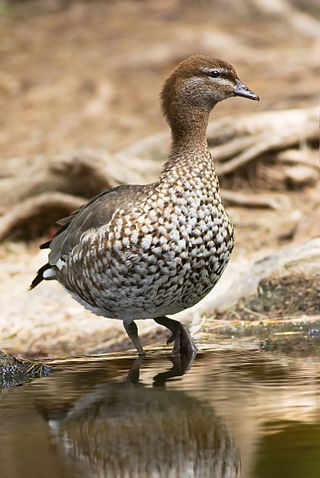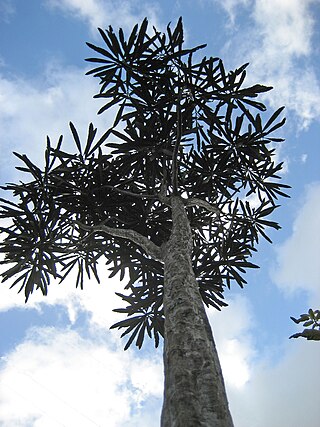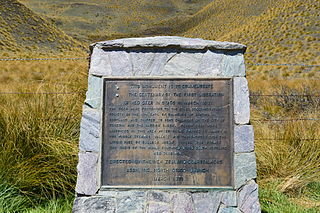
The Canada goose (Branta canadensis) was introduced to New Zealand as a game bird in 1905. They became problematic because of damage they cause to pastures and crops.

The Canada goose (Branta canadensis) was introduced to New Zealand as a game bird in 1905. They became problematic because of damage they cause to pastures and crops.
Canada geese were introduced as a game bird into New Zealand in 1905. [1] They were protected under the Wildlife Act of 1953 and the population was managed by Fish and Game New Zealand who culled excessive bird numbers. The number of birds increased and by 1996 they had reached an estimated population of 40,000 in the South Island. [1] In 2011 the government removed the protection status allowing anyone to kill the birds. [2] [3]
In the lead-up to 2011, farmers felt that not enough was being done to control the population. They lobbied the government to have the designation changed so landowners could manage birds on their own properties. The then-conservation minister, Kate Wilkinson, changed its status, putting the birds in the same bracket as sparrows and pigeons. Fish and Game councils lost the authority to manage the species, and requirements for a shooting permit were dropped. [4] An analysis of options prepared by Department of Conservation (DOC) considered that changing the status of Canada geese from 'Schedule 1' of the Wildlife Act 1953 (game birds) to 'Schedule 5' (not protected) would provide the best match against the overall objectives of a) ensuring landowners and managers do not bear the unacceptable costs from Canada goose impacts, b) ensure that Canada geese do not pose an unacceptable risk to aviation safety, and c) maximising recreational hunting opportunities (subject to (a) and (b) being met). [5]
Fish and Game and hunters opposed the change, labeling the move 'a costly own goal' and later 'one of the most bizarre government decisions in the history of managed gamebird hunting in New Zealand'. [6] [7] Controversy about management has dated from at least 2006 when it was reported that farmers wanted lower numbers and Fish & Game wanted more financial support from farmers to support control efforts. [8]
Canada geese are often seen in pastures and in the braided river valleys of the South Island and damage to pastures was reported as early as 1925. They affect pastures by competing for food with the farmed animals and by leaving droppings. The birds may also be responsible for some damage to crops. [1]
Haumia-tiketike is the god of all uncultivated vegetative food in Māori mythology. He is particularly associated with the starchy rhizome of the Pteridium esculentum, which became a major element of the Māori diet in former times. He contrasts with Rongo, the god of kūmara and all cultivated food plants.

The red-breasted goose is a brightly marked species of goose in the genus Branta from Eurasia. It is currently classified as vulnerable by the IUCN.

The Canada goose is a large species of goose with a black head and neck, white cheeks, white under its chin, and a brown body. It is native to the arctic and temperate regions of North America, and it is occasionally found during migration across the Atlantic in northern Europe. It has been introduced to France, the United Kingdom, Ireland, Finland, Sweden, Denmark, New Zealand, Japan, Chile, Argentina, and the Falkland Islands. Like most geese, the Canada goose is primarily herbivorous and normally migratory; often found on or close to fresh water, the Canada goose is also common in brackish marshes, estuaries, and lagoons.

The Australian wood duck, maned duck or maned goose is a dabbling duck found throughout much of Australia. It is the only living species in the genus Chenonetta. Traditionally placed in the subfamily Anatinae, it might belong to the subfamily Tadorninae (shelducks); the ringed teal may be its closest living relative.

A number of introduced species, some of which have become invasive species, have been added to New Zealand's native flora and fauna. Both deliberate and accidental introductions have been made from the time of the first human settlement, with several waves of Polynesian people at some time before the year 1300, followed by Europeans after 1769.

The cackling goose is a species of goose found in North America and East Asia.

Landcare Research is a New Zealand Crown Research Institute whose focus of research is the environment, biodiversity, and sustainability.

Pseudopanax crassifolius, also known as horoeka or lancewood, is a heteroblastic tree belonging to the family Araliaceae. It is endemic to New Zealand and found throughout the country from sea level up to about 750 m in lowland to montane shrublands and forests.

Baskett Slough National Wildlife Refuge is in northwestern Oregon, 10 miles (16 km) west of Salem in Polk County. The Refuge consists of 1,173 acres (4.75 km2) of cropland, which provide forage for wintering geese, 300 acres (1.2 km2) of forests, 550 acres (2.2 km2) of grasslands, and 500 acres (2.0 km2) of shallow water seasonal wetlands and 35 acres (0.14 km2) of permanent open water. In 1965, Baskett Slough National Wildlife Refuge was created to help ensure some of the original habitat remained for species preservation. The refuge is managed by the U.S. Fish and Wildlife Service, an agency of the U.S. Department of the Interior.

Pterophylla racemosa, commonly known as the kāmahi, is an evergreen tree endemic to New Zealand. It is part of the Pterophylla genus which mostly includes sub-tropical species, but the kāmahi is found in a variety of New Zealand climates from coastal areas to high-elevation inland areas.

The Nelson green gecko or starred gecko is a species of the family Gekkonidae (gecko). The neotype is in the collection of the Museum of New Zealand Te Papa Tongarewa.

The environment of New Zealand is characterised by an endemic flora and fauna which has evolved in near isolation from the rest of the world. The main islands of New Zealand span two biomes, temperate and subtropical, complicated by large mountainous areas above the tree line. There are also numerous smaller islands which extend into the subantarctic. The prevailing weather systems bring significantly more rain to the west of the country. New Zealand's territorial waters cover a much larger area than its landmass and extend over the continental shelf and abyssal plateau in the South Pacific Ocean, Tasman Sea and Southern ocean.

The New Zealand goose is a bird of the extinct genus Cnemiornis of the family Anatidae, subfamily Anserinae. The genus, endemic to New Zealand, consisted of two species: the North Island goose, C. gracilis and the South Island goose C. calcitrans.

Hunting is a popular recreational pursuit and a tourist activity in New Zealand with numerous books and magazines published on the topic. Unlike most other developed countries with a hunting tradition, there are no bag-limits or seasons for hunting large game in New Zealand. Hunting in national parks is a permitted activity. The wide variety of game animals and the limited restrictions means hunting is a popular pastime which has resulted in a high level of firearms ownership among civilians.
Kiwaia jeanae, also known as the Kaitorete jumper or mat daisy jumper, is a species of moth in the family Gelechiidae. It is endemic to New Zealand. This species is classified as "At Risk, Naturally Uncommon" by the Department of Conservation. Both the males and females of this species are brachypterous.

Myrsine divaricata also known as weeping māpou or weeping matipo, is a small tree up to 4 metres (13 ft) tall or often a shrub endemic to New Zealand. It has a strongly divaricating habit with interlaced branches. The woody parts are stiff and pubescent when young. The small leathery simple leaves are borne on short petioles and may be slightly two lobed at the end. The very small yellow or reddish flowers may be borne singly or in small groups which mature into small purple, occasionally white, fruit.
The dusky Canada goose is a subspecies of the Canada goose. They are the darkest variant, similar to the Pacific cackling goose. Tagged dusky geese have red bands with white letters on them attached to their neck. They represent one of the smallest populations of Canada goose in the Pacific Northwest. Due to the species' minimal population and exclusive breeding grounds, the dusky Canada goose is a species of interest to the Pacific Flyway Council and the U.S. Forest Service. The Cordova Ranger District, on the Chugach National Forest, has been working since 1984 to implement a monitoring and restoration program for the geese.

The Moffitt's Canada goose, also known as the Western Canada goose or Great Basin Canada Goose is a subspecies of the Canada goose. Native to the western interior of North America surrounding the Rocky Mountains, its range has expanded due to introductions to various regions of western North America.

Janet Mary Wilmshurst is a New Zealand palaeoecologist who works on reconstructing the ecological past. Wilmshurst has been a Fellow of the Royal Society Te Apārangi since 2015. She was president of the New Zealand Ecological Society, and currently works as principal scientist in long-term ecology at Manaaki Whenua Landcare Research focusing on recent fossil records to reconstruct and trace past ecosystem changes in response to natural disturbance.
The New Zealand Fungarium (PDD): Te Kohinga Hekaheka o Aotearoa is the major collection of fungi from Aotearoa. It is one of the largest collections in the Southern Hemisphere. The Fungarium is designated a Nationally Significant Collection by the Ministry of Business, Innovation and Employment.